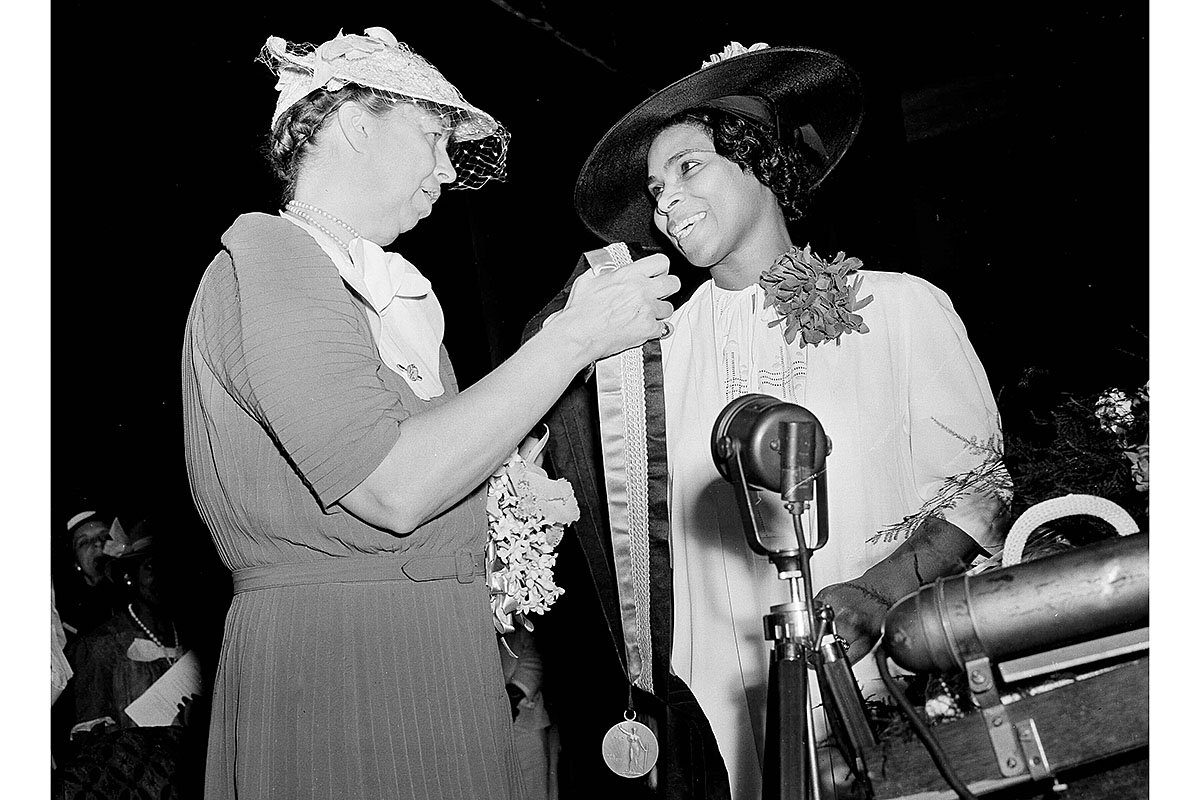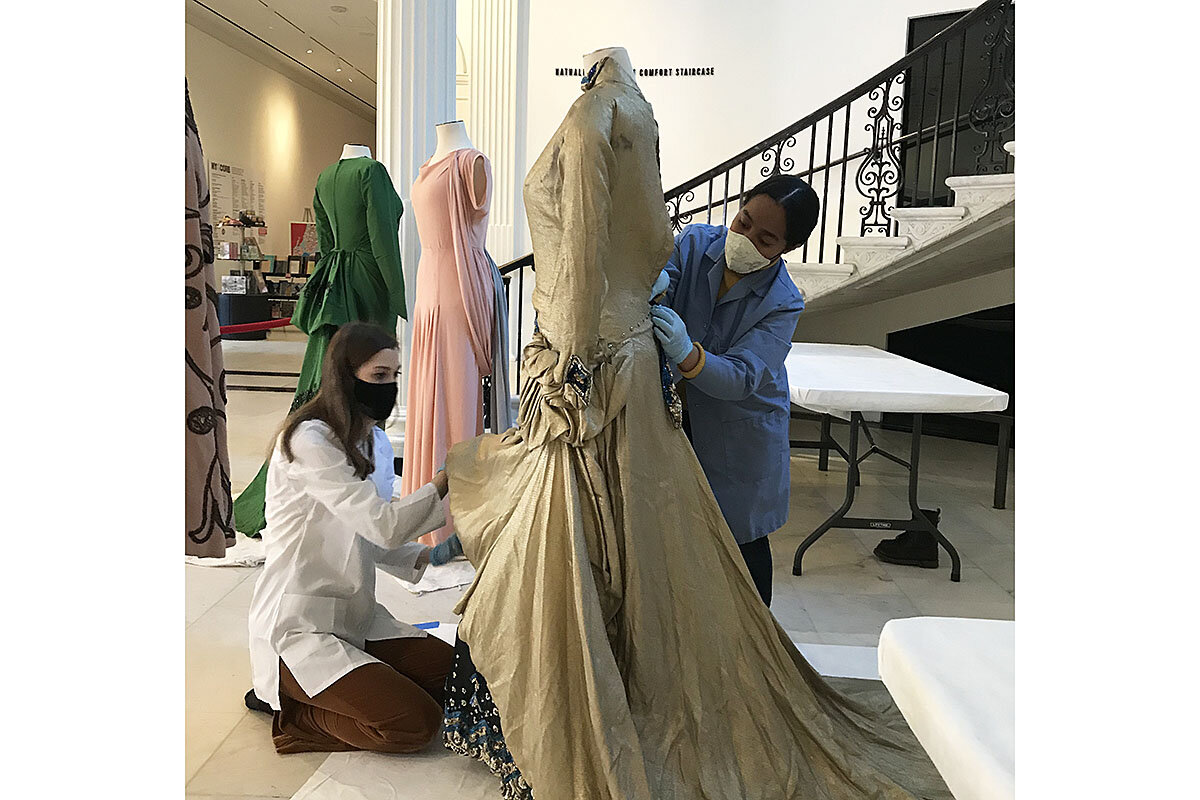Fame and fashion: Marian Anderson’s quiet inauguration activism
Loading...
| New York
“Be a credit to the race.”
“Don’t disgrace the race.”
Those were the admonitions I heard as a child in the 1950s. In essence, my elders were saying that as an African American girl, I shouldn’t contribute to the omnipresent, demeaning images of Black people in the media, a continuing legacy of the Jim Crow era. I should be well dressed and well groomed. I should “represent” my race as intelligent and diligent, accomplished and hardworking. I shouldn’t contribute to or believe what Martin Luther King Jr., in a comment honoring W.E.B. Du Bois, called a “poisonous fog of lies,” lies that depicted Black people as inferior and deficient.
Why We Wrote This
Truth has a way of making itself known. For years, Black women have used their fashion choices as a form of quiet activism, proclaiming their dignity without saying a word.
Fame and fashion as protest
Glorious operatic contralto Marian Anderson died in 1993, but in connection with last week’s inauguration, the Museum of the City of New York is spotlighting her role as a groundbreaker in both Republican and Democratic inaugurations and her influence as a fashion icon. Anderson “represented” the very best of her race. She may not have seen herself as an activist, but she was a pioneer, an extraordinarily accomplished Black woman who deliberately used her fame and fashion choices to counter the prevailing stereotypes of Black women.
In 1957, Anderson broke a major color barrier when she sang the national anthem at President Dwight Eisenhower’s second inauguration. During his first term in office, racial and social unrest had accompanied the 1954 Brown v. Board of Education Supreme Court decision, which declared segregation in public schools unconstitutional. His first term also saw Rosa Parks’ refusal to surrender her seat on a city bus, which triggered the Montgomery bus boycott. In reaction to the turmoil, President Eisenhower issued an invitation to the Black star who, as Allen McDuffee in Timeline writes, “had somewhat reluctantly become a face of social change in America.” Four years later, Anderson again performed “The Star-Spangled Banner” at the inauguration of President John F. Kennedy.
Almost two decades earlier, in 1939, Anderson had been thrust into a very harsh, public glare of racism when the Daughters of the American Revolution refused to allow her to perform in their Constitution Hall because of her race. That well-publicized snub led to first lady Eleanor Roosevelt’s withdrawal of her DAR membership and to an invitation from the federal government for Anderson to give a free concert at the Lincoln Memorial. The Easter Sunday performance drew some 75,000 people. Later that year, Roosevelt presented Anderson with the Spingarn Medal, awarded by the NAACP. Again, Anderson was elegantly dressed.
Quiet activism
In this season of inaugurations and celebrations of the power and brilliance of women of color, as a balm to soothe the stresses of the current, violent racial reckoning, the Museum of the City of New York unveiled four treasures from its archives: a coat and three gowns that Anderson wore on stages around the world in the 1930s and ’40s.
The fashions showcase Anderson’s quiet activism. She didn’t want to be known as a “dazzler,” Callie O’Connor, collections assistant in the museum’s Costume and Textiles Collection, told me. Instead, Anderson’s brand of activism was reflected in her elegant, well-made gowns and her insistence that all of her programs be open to fully integrated audiences.
The museum’s notes about the dresses quote Anderson’s autobiography, “My Lord, What a Morning.” She wrote: “The first impression on an audience is the visual one, and one should wear what is right for one’s type. … I like simple, tasteful clothes; I do not go in for things that dazzle.”
Since the museum is unable to welcome large numbers of visitors because of the pandemic, it is launching a digital installation for Black History Month to celebrate Marian Anderson and her legacy.
The fashions in the digital presentation (and pictured at the beginning of the article) include a variety of fabrics and styles:
- An emerald green silk taffeta concert gown with black silk and beaded embroidery (shown from the back), made in 1947 and worn in a series of portraits taken by Carl Van Vechten in 1947.
- A pale peach and powder blue crepe back satin gown, purchased at the Nordiska Kompaniet department store in Stockholm, Sweden, around 1934.
- A gold lamé concert gown lined in peacock blue silk, featuring an underskirt of black chiffon embroidered with iridescent sequins. The gown, which cost $310, was custom-made for Anderson by Eaves Costume Company of New York in 1938 and was purchased at the same time as the gown she wore for the Lincoln Memorial concert.
- An evening coat in navy and pink cashmere wool crepe with gilt embroidery and applied navy silk cord, purchased at the Wanamaker’s department store in Philadelphia where Anderson’s mother once worked for substandard wages.
Singer, songwriter, and actress Bette Midler purchased the gowns at auction after Anderson’s death and donated them to the Museum of the City of New York.
Hearing my elders’ voices
When Whitney W. Donhauser, the museum’s Ronay Menschel director and president, asked me to participate in the digital presentation, she called Anderson “a quiet but continuous force for racial equality,” adding, “We would do well to remember Anderson’s unmistakable voice for the 2021 inauguration.”
During my career as a CBS News White House correspondent during the Ronald Reagan and George H.W. Bush presidencies, I, too, attempted to model quiet activism through my “simple, tasteful” fashion choices. Knowing that my image appeared on televisions in countless homes during the 1970s, ’80s, and ’90s – and hearing my elders’ voices – I did my best to “be a credit to the race.”
The fashion choices at last week’s inauguration also carried a message, as several publications noted. Vanity Fair included Vice President Kamala Harris’ choice of a coat and dress by African American designer Christopher John Rogers in the day’s “displays of fashion diplomacy.” And The New York Times cited the vice president’s fashion as a tool “to underscore [the] message of fresh starts and racial justice, help and healing.”
Activism and “representation” were and are ever-present choices for all women, but especially for Black women in the public eye.
Jacqueline Adams is co-author of “A Blessing: Women of Color Teaming Up to Lead, Empower and Thrive.”







